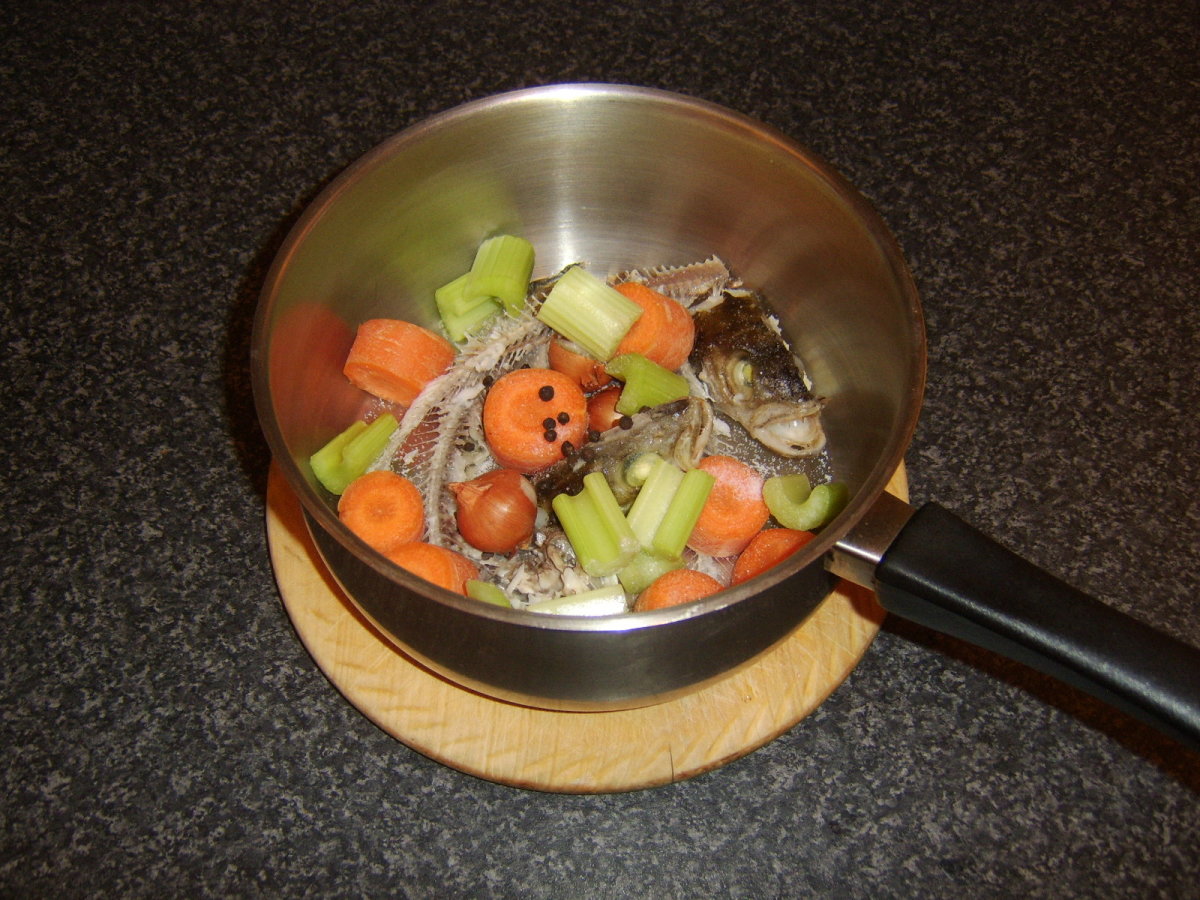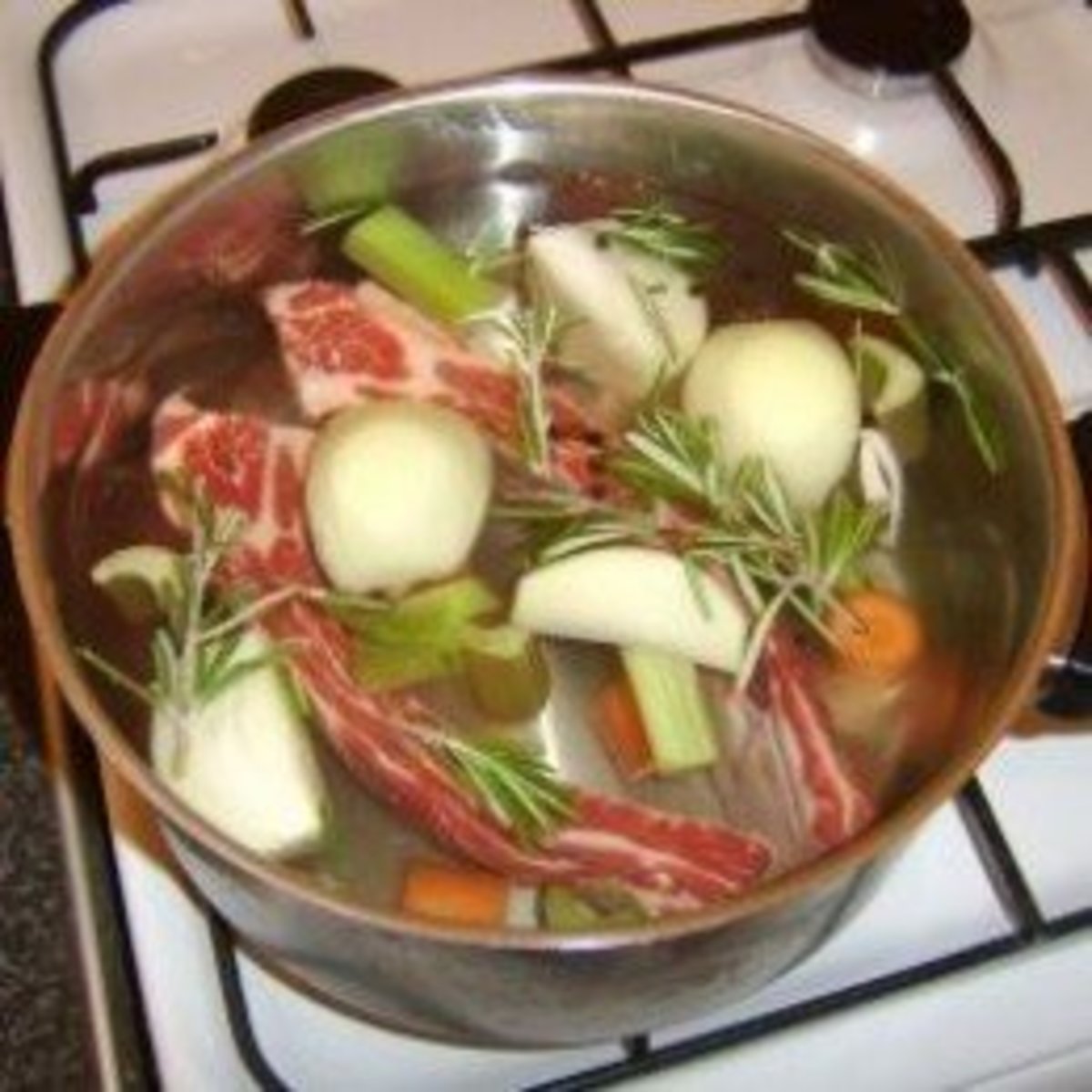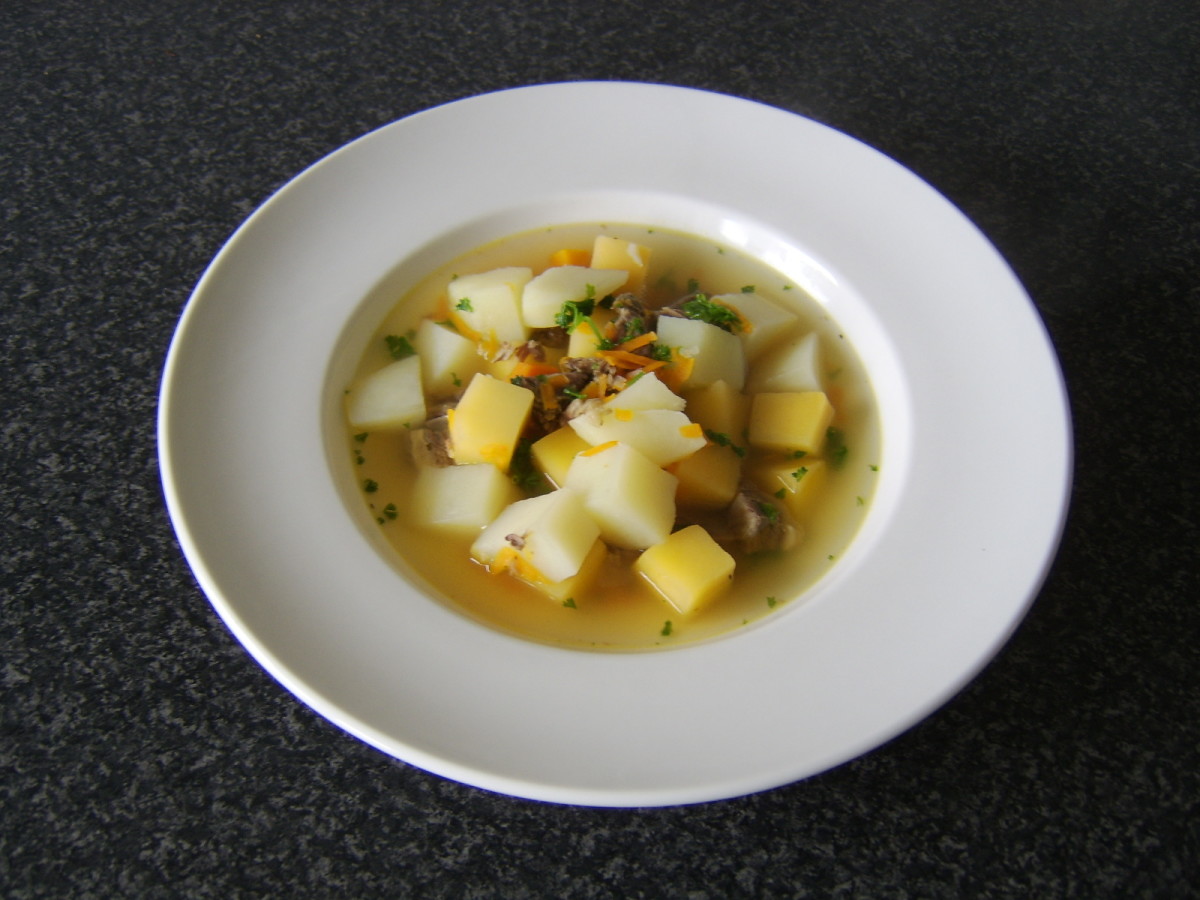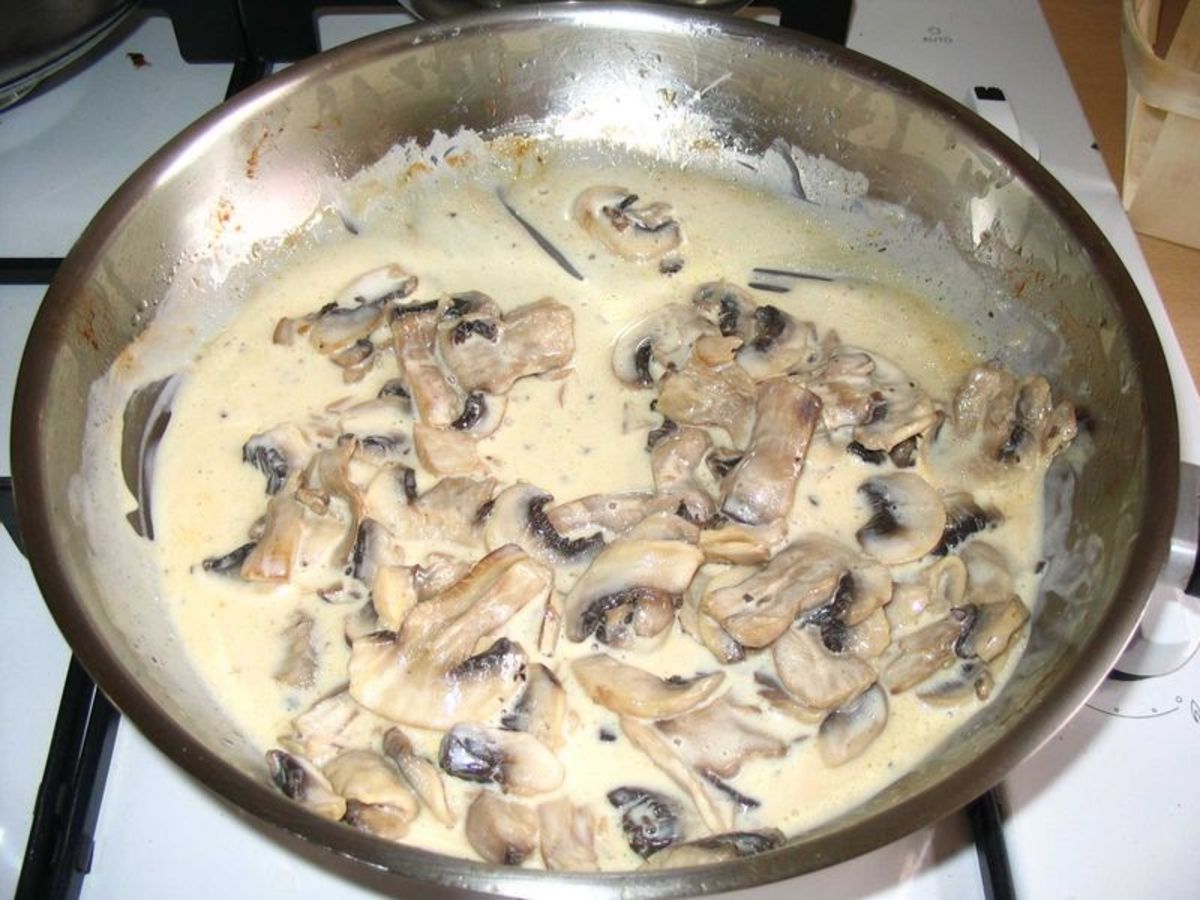The Importance of Stock and its Relationship in a Good Sauce

What is a stock?
Stock is a flavoured liquid reduction made from any of the following;
- Fish
- Meat
- Chicken
- Vegetables
For some the "modus operandi" of stock making will be just another recipe, and a decent stock can be made by throwing in "this and that , and simmering x amt of time".
But a good stock is so much more!
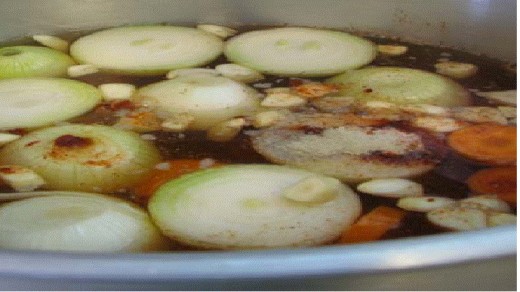
Stocks
A good Stock takes time and effort, as the resulting broths are the "Fond de veau" of many leading sauces.
Stocks are the result of extracting flavours and nutrients through a method of infusion and reduction-removing the excess water to reach the desired consistency,which results in a rich intense flavour.
When making White Stock the method differs from that of Brown Stock as the bones are blanched and not roasted. This ensures that all impurities are removed and produces a clear stock.
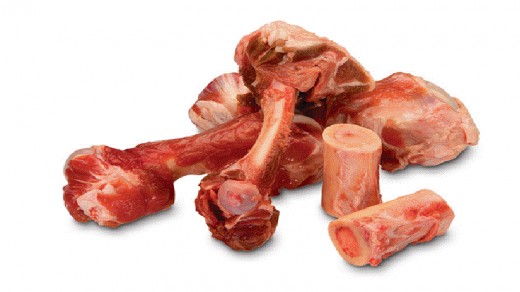
Ingredients in a Stock Pot and their Properties
Bones :-
These contain collagen and when simmered forms gelatine . The body of a good stock depends on this gelatine to solidify when chilled. (The more gelatine in a stock the more body it will have).
Knuckle bones and veal bones are two good sources of bones high in cartilage. Also useful in stock is the skin and connective tissues of animals.
The stock must be cooled to 70 degrees within the hour to prevent the growth of bacteria.
Cold Water :-
Albumin is a protein which will only dissolve in cold water and it is important in the fact that it helps to clarify a stock.
Therefore it is essential to start a stock pot with cold water in order to release the albumin which in turn will produce a much clearer stock.
Water also helps to remove impurities.

Flavourings and Aromatics
These can take the form of;
- Mirepoix
- Sachet d'epices
- Bouquet Garni
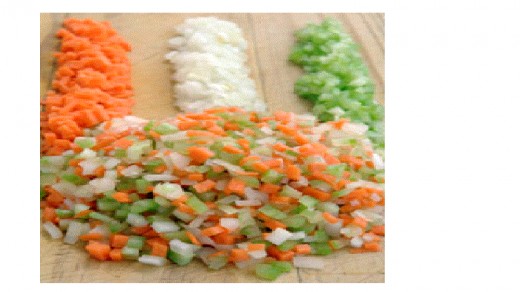
Mirepoix
This is a combination of
- Onions
- Carrots
- Celery
prepared in a ratio 2 : 1 : 1 which is used to add flavour and aroma to Soups, Stews, Stocks, Sauces and Casseroles.
This "Trinity" of basic ingredients used in the above mentioned ratio provide stock, soups and other dishes with a destinctive earthy flavour.
The mirepoix is strained out of the finished stock via a Chinois (China Cup). The more finely the mirepoix is chopped the quicker the flavour and aroma is released into the stock.
Although it is quite acceptable to cut the mirepoix vegetables for the roasting of the bones in the oven 1" cubed.

Mirepoix for Brown Stock
In making Brown Stock use;
1 lb of Mirepoix
6 pints of Cold Water
♦ 16 fluid ozs in a US pint
♦ 20 fluid ozs in a UK pint
In the case of a Brown Stock the Mirepoix is roasted before being added to the Stock Liquid.
METHOD:
- Preheat oven to 400 °F
- Place beef or veal bones in a heavy bottomed roasting tin. Drizzle them with a little oil
- Roast bones for approx half an hour
- Add the mirepoix to the roasting tin and continue roasting for another half an hour. Toward the end of the roasting, add in the tomato product.
- When the bones are thoroughly browned, remove the roasting tin from the oven and transfer the bones to a heavy-bottomed stockpot
- Add enough cold water to the pot to completely cover the bones
- Bring pot to a boil, then immediately lower the heat so as to simmer
- Skim off any scum that rises to the surface
- Add the roasted mirepoix to the pot along with a sachet d'epices, tie the sachet string to the stockpot handle so as it can be removed later
- Continue to simmer the stock and skim any impurities that rise to the surface. Liquid will evaporate, so make sure there's always enough water to cover the bones
- After 4 to 6 hours, once the stock has developed a rich, brown color, remove the pot from the heat
- Strain the stock, and cool to 70 degrees with in the hour and refrigerate
This Stock is used to make Espagnole Sauce (Brown Sauce)
Other sauces that are derived from Espagnole Sauce are;
- Bordelaise Sauce - served with beef dishes
- Maderia Sauce - served with beef or chicken depending on stock used
- Mushroom Sauce - served with chicken or beef depending on stock used
- Lyonnaise sauce - served with veal
- Robert Sauce - servrd with pork
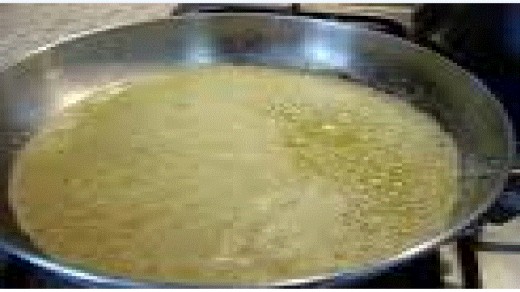
Mirepoix for White Stock
In making White Stock use;
1 lb of Mirepoix (substitute the carrots for parsnips and mushrooms).
5 pints of Cold Water
♦ 16 fluid ozs in a US pint
♦ 20 fluid ozs in a UK pint
METHOD:
- Rinse the bones in cold water
- Then transfer the bones into a heavy-bottomed stockpot
- Cover the bones completely with cold water, in the pot
- Bring pot to a boil, then drain and rinse the bones
- Returning the blanched bones to the pot once again cover with fresh, cold water
- Bring the pot to the boil, then immediately lower the heat to simmer
- Skim off any scum that rises to the surface
- A this point add your Mirepoix to the pot along with the Sachet d'epices, and tie it to the handle of the pot
- Continue to simmer the stock and skim any impurities that rise to the surface. Liquid will evaporate, so always make sure there's sufficient water to cover the bones
- After 4 / 6 hours, remove the pot from the heat
- Strain the stock, and cool to 70 degrees with in the hour and refrigerate
This Stock is used to make a Veloute Sauce (Blond Sauce)
Other sauces that are derived from Veloute Sauce are;
- Allemande sauce - served with veal dishes
- Aurore sauce - served with fish.chicken and egg dishes
- Supreme sauce - served with chicken
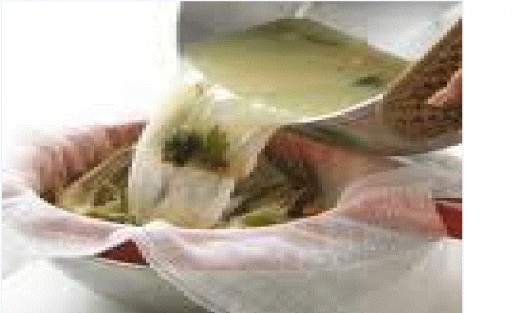
Mirepoix for Fish Stock
½ lb Mirepoix
20 fluid ozs Cold Water
½ lb Fish Bones
White wine
- TIP
When adding wine to a pot or sauce start at the handle and do a full circle of 360 degrees around rim, this will add sufficient wine to your pot.
Cook the mirepoix and fish bones slightly in butter before adding the cold water.
Leeks can be mixed with the onions in a mirepoix.
If a white mirepoix is required then substitute the carrots for parsnips and mushrooms.
Fish stock, or fumé as it's known in French, is a quick and easy stock to make. This makes a really brilliant base for fish soups, chowders, etc.
It's best to use fish bones from mild, lean, white fish like halibut, cod or flounder.
Fish to avoid are salmon, trout, mackerel or other oily, fatty fish
METHOD:
- In a heavy-bottomed stock pot,heat the butter over medium heat
- Lower the heat, add the vegetables and sweat with the lid on, approx 5 minutes or until the onions are softened but slightly translucent. Don't brown the vegetables
- Add the fish bones and sweat for another couple of minutes, keep lid on, until the bones are slightly opaque
- Add the wine and heat until it starts to simmer. Now add the Sachet d'epices and water,raise heat to allow to simmer and let simmer for 30-45 minutes
- Strain the stock, and cool to 70 degrees with in the hour and refrigerate
This Stock is used to make a Fish Veloute
Other sauces that are derived from Fish Veloute are;
- Bercy sauce - served with fish or sea food dishes
- Venetian Sauce - destinct tarragon flavour
- White Wine Sauce - creamy sauce
-
Normandy sauce - rich flavoured sauce made with mushrooms and Oyster Liquid
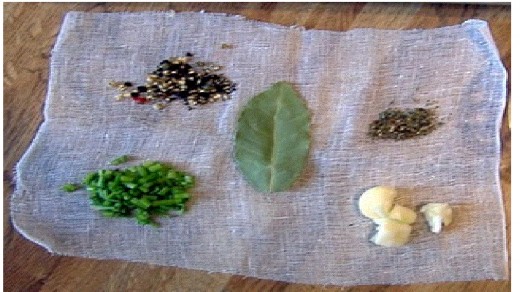
Sachet d'epices
This is a small pouch of Herbs and Spices which is used to add additional flavour to Stocks.
This contains;
- Dried Thyme
- Parsley Stems
- Bay Leaf
- Whole Peppercorns
- Whole Cloves of Garlic
The Herbs and Spices are put into a small pouch and tied securely after which they are attached to the handle of the Stock Pot and suspended therein via cooking twine.

Bouquet Garni
This is a bundle of Herbs and Aromatics tied up within the sections of a Leek and suspended into the Stock Pot from the handle via a piece of cooking twine.
- Celery
- Fresh Thyme
- Parsley Stalks
- Bay Leaf
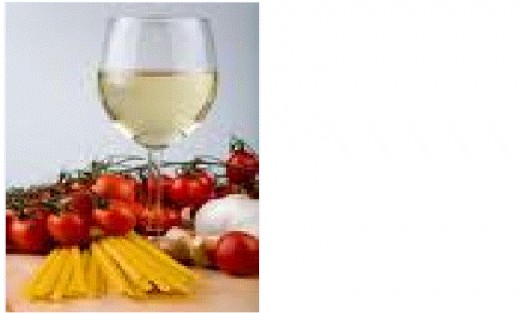
The effects of Acid and Stock
Acid is used in Stocks to help break down the cartilage and connective tissues which in turn helps to accelerate the formation of Gelatine.
Acid for Stocks can be found in the following forms;
- Tomatoes for Brown Stocks
This also helps to add flavour and colour to the Stock
- White Wine
This is used when making White Stock, Chicken Stock and Fish Stocks
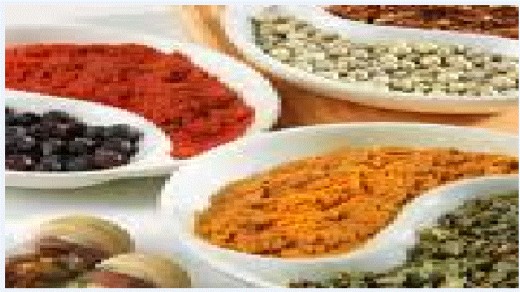
Seasoning
When making a Demi-Glaze the Stock is further reduced, so it is not advisable to season your Stock at this stage of preparations.
Keeping a small container of seasoning near your "mise en place" is recommended, for any adjustments that may be required just before service.

